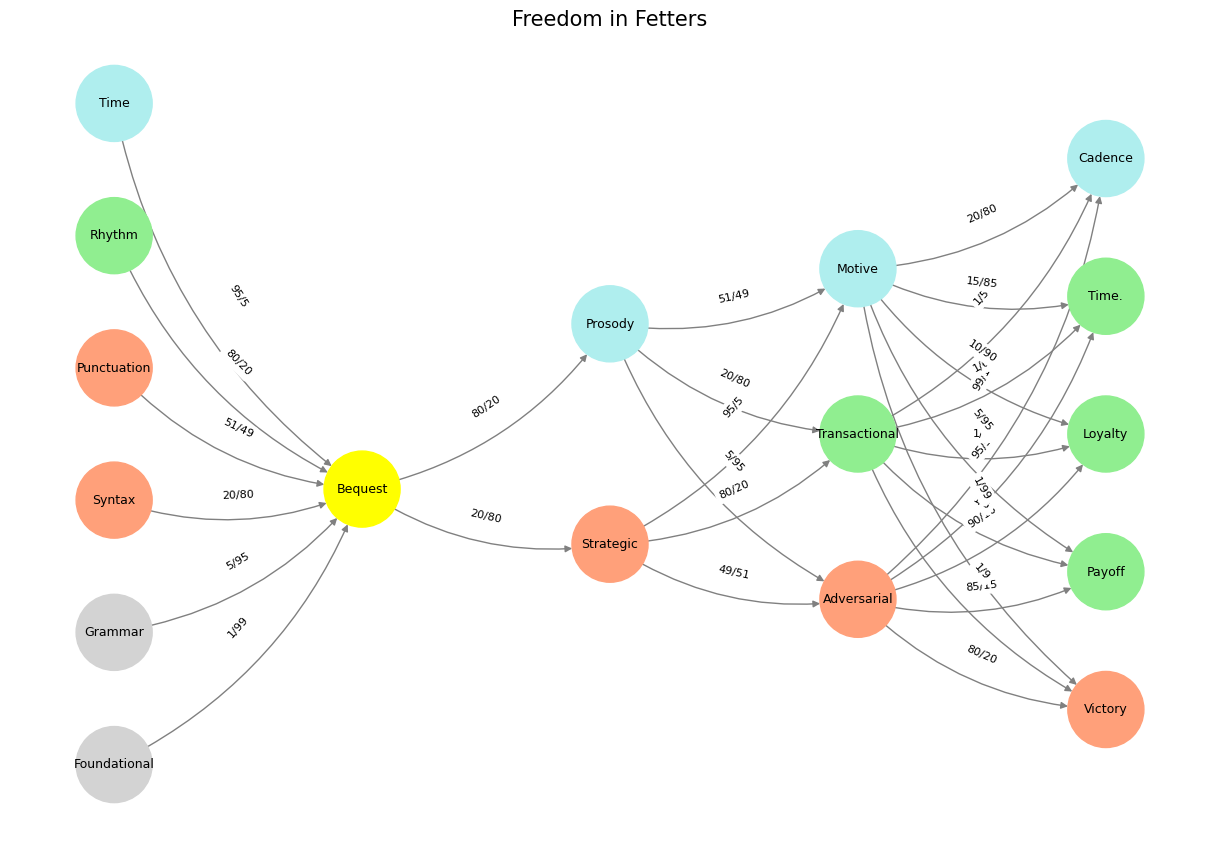Dancing in Chains#
The Murdoch Cadence is a Victorian cadence, an ending marked by finality, by a culmination of wealth, power, and ideological certainty, yet threatened by the entropy of succession, by the fraying edges of a world that will soon move beyond its architect’s intentions. It is Rupert Murdoch’s dying wish to ensure that the Anglo-Saxon megaphone he has built does not fall into hands that will dilute its purpose. He craves a resonance that will last beyond him, a structural integrity in his media empire that will maintain its equilibrium against the forces of liberal entropy. But history is unkind to such desires.
This is the cadence of the Victorian novel, where confidence in the British order reaches its climax, only for the 20th century to unravel its strict determinism. The grand, sprawling worlds of Dickens, Thackeray, and Eliot close with a flourish—marriages, fortunes, reconciliations—but the very certainty of these endings is, in retrospect, a form of fiction. The 19th century closed with supreme confidence in empire, in industry, in the self-made man’s right to dominion. Yet, as the world moved into the uncertainties of the 20th century—marked by Lawrence of Arabia’s disillusionment, by the First World War’s mechanical slaughter, by the existential instability of modernism—the cadence no longer held. The British order fragmented, its cadence becoming more of a dissonance.
Murdoch stands at the edge of such a transition. His succession problem echoes the fissures in his ideological project. Lachlan, his chosen heir, embodies the certainty Murdoch wishes to project. Conservative, aligned with his father’s instincts, a man ready to safeguard Fox News, The Sun, The Times, The Wall Street Journal. The signal remains intact. James (Jacob), the younger by a mere year and a half, is a disruption—liberal, detached, a destabilizing force whose mere existence suggests that the certainty of Murdoch’s Anglo-Saxon conservatism is already in question. The succession fight over the Murdoch Trust is not merely a legal battle over money; it is a fight over whether the Murdoch Cadence can even hold.
In many ways, Murdoch’s media empire is structured like a thalamocortical gating system, regulating the flow of information, amplifying certain signals while suppressing others. The conservative press functions as a high-pass filter, allowing only the resonant frequencies of Anglo-American triumphalism to emerge, while liberal dissent is treated as noise. But what happens when the regulator himself is dying? When the gating function begins to fail? The Murdoch network has been a signal enhancer for decades, a Lewis Hamilton in a Mercedes, fine-tuned for performance, engineered for dominance. Yet, in Formula One, as in media, dynasties fall when the system shifts. Ferrari once ruled; then came McLaren; then Red Bull disrupted the scene. No hegemony lasts forever—not in racing, not in politics, not in media. The Kentucky Derby is won in bursts, in moments where jockey and horse move as one, but after the finish line, the horse is spent, the moment fades. Murdoch’s megaphone, however loud, will one day be overtaken by a new race, a new cadence.
Dostoevsky’s The Gambler offers another lens on Murdoch’s predicament. The gambler, much like the media mogul, believes in the power of will, in his ability to shape his own fate through sheer audacity. Murdoch has spent his life placing bets—on news networks, on newspapers, on elections, on culture wars. He has mastered the art of provocation, of tilting the balance of history toward his own ideological image. But every gambler, even the greatest, faces the moment where the wheel no longer lands in their favor. Dostoevsky understood that gambling is not about the numbers, nor even about the money—it is about the illusion of control. Murdoch, at 93, is confronting that very illusion. No matter how much he seeks to stack the odds, to orchestrate the outcome, succession has an element of chance that cannot be dictated.
Raphael’s The School of Athens is, at first glance, a work of perfect equilibrium. Apollo and Athena preside over the order of knowledge. Plato gestures upward, Aristotle outward—the eternal debate between the ideal and the practical. Yet beneath this structured harmony is something deeper: the transient nature of thought itself. Philosophies rise and fall, old orders dissolve into new ones. Even the most powerful ideological structures—be they religious, philosophical, or media-driven—are subject to the entropy of discourse. Murdoch’s vision for the Anglo-speaking world is a form of Platonic idealism—fixed, immutable, enduring—but the reality is more Aristotelian: messy, contingent, evolutionary. The louder the megaphone, the greater the distortion.
What Murdoch seeks is an aristocratic endgame, a controlled cadence, like a well-executed final chord in a symphony. But what if the cadence never resolves? What if, instead, it fragments into the kind of open-ended dissonance that defined 20th-century music? The clarity of the Victorian cadence gave way to the atonality of Schoenberg, to the unresolved tension of Mahler, to the fractured, polyphonic modernism of Stravinsky. The Western canon itself evolved away from resolution. If Murdoch’s life has been a Beethoven symphony, full of force and will, his ending may be more akin to Berg’s Wozzeck—a world where structure collapses, where no final resolution is granted.
Perhaps the Murdoch Cadence is not a cadence at all. Perhaps it is a lingering fermata, a note held in suspension, its resolution uncertain. He has built his media empire to ensure ideological clarity, yet his own family embodies the very ambiguity he fears most. His legacy is being fought over not just in legal courts, but in the deeper battleground of ideas.
And what if the gamble does not pay off? What if, despite all his calculations, the ideological signal he has spent his life amplifying does not survive his death? The irony of the gambler is that even when they win, they can never fully control the game. The irony of the media mogul is that even when they build the loudest megaphone, they cannot control who will wield it next.
Rupert Murdoch’s cadence is Victorian in structure, but modernist in consequence. He craves certainty, but history rarely grants such favors. Perhaps, in the end, his greatest creation was not the signal, but the noise that inevitably follows.

Fig. 33 Freedom in Fetters—a Princely Freedom. Chopin, the last of the modern musicians, who gazed at and worshipped beauty, like Leopardi; Chopin, the Pole, the inimitable (none that came before or after him has a right to this name)—Chopin had the same princely punctilio in convention (grammar, space) that Raphael shows in the use of the simplest traditional colours. The only difference is that Chopin applies them not to colour but to melodic and rhythmic traditions (prosody, time). He admitted the validity of these traditions because he was born under the sway of etiquette. But in these fetters he plays and dances as the freest and daintiest of spirits, and, be it observed, he does not spurn the chain. Source: Human All-Too-Human Part II#
This alignment maps well onto a thalamocortical gating framework, where information flow is filtered and prioritized by the thalamus before reaching cortical processing centers. If we integrate GLP-1 agonists (which modulate metabolic pathways, reward processing, and satiety) and Athena’s shield (symbolizing strategic defense and wisdom), we can position these five categories along a neurobiological and decision-theoretic axis.
Neural and Strategic Mapping:#
Resource, Ignorance (95/5) 🪙 🎲 🎰 🛡️ 🗡️ 🪖 🔥
Thalamic Filtering (Gating Priority: Low)
Most input data is noise; filtering is minimal.
Coin flips, dice rolls, and war-related symbols suggest adversarial and chance-based systems.
GLP-1 and Reward Pathway:
Minimal regulatory influence—this is a raw, resource-driven state.
Athena’s Shield:
Weak or absent—wisdom has not yet entered the equation.
Strategy: Adversarial, exploitative, chaotic. Operates on fundamental scarcity.
Resourceful, Provoke (80/20) ♣️ ♦️ ♥️ 😓 🎭 👁️ 🦉
Thalamic Filtering (Gating Priority: Moderate-Low)
Higher information selection, but still significant noise.
GLP-1 and Reward Pathway:
Increased metabolic control—engagement with strategic planning.
Athena’s Shield:
Emerging—crafting deception, poker, and persuasion.
Strategy: Iterative; shifts between exploitative and cooperative equilibria.
Razors-edge, Strategy (51/49) 🪒 🏇 🏎️
Thalamic Filtering (Gating Priority: High)
Near-optimal balance of signal and noise.
GLP-1 and Reward Pathway:
High optimization—metabolic efficiency linked to cognitive sharpness.
Athena’s Shield:
Strongly present—strategic decisions are balanced at an inflection point.
Strategy: Fast execution, immediate payoff decisions.
Risk, Knowledge (20/80) ♟️ 🐍 🤺 💵 🛌
Thalamic Filtering (Gating Priority: Very High)
High selectivity for known patterns, rejecting low-value noise.
GLP-1 and Reward Pathway:
Controlled energy expenditure—risk is known, but must be weighed.
Athena’s Shield:
Defensive strategies at peak—cunning (snake) and calculated risk (chess).
Strategy: Informed tactical decision-making, with survivalist trade-offs.
Reward, Certainty (5/95) 💍 🕊️ 🎻 🎼 🎵 ☁️ ✨
Thalamic Filtering (Gating Priority: Maximum Precision)
Selects only the most refined, highest-value inputs.
GLP-1 and Reward Pathway:
Full regulatory dominance—long-term satiety, stability, and harmony.
Athena’s Shield:
Fully activated—divine wisdom, cultural legacy, artistic flourishing.
Strategy: Fully cooperative equilibrium; optimal balance of risk and reward.
Overall Integration:#
Thalamocortical gating ensures an optimal level of filtering across these decision stages.
GLP-1 agonists reinforce control, allowing transitions between resource-driven impulsivity and high-level cognition.
Athena’s shield is a regulatory function that increases as risk diminishes and certainty solidifies.
This framework now reflects a dynamic interplay between impulsivity, calculated risk, and strategic certainty—with gating mechanisms deciding the level of noise tolerance at each stage.
Show code cell source
import numpy as np
import matplotlib.pyplot as plt
import networkx as nx
# Define the neural network layers
def define_layers():
return {
'Suis': ['Foundational', 'Grammar', 'Syntax', 'Punctuation', "Rhythm", 'Time'], # Static
'Voir': ['Bequest'],
'Choisis': ['Strategic', 'Prosody'],
'Deviens': ['Adversarial', 'Transactional', 'Motive'],
"M'èléve": ['Victory', 'Payoff', 'Loyalty', 'Time.', 'Cadence']
}
# Assign colors to nodes
def assign_colors():
color_map = {
'yellow': ['Bequest'],
'paleturquoise': ['Time', 'Prosody', 'Motive', 'Cadence'],
'lightgreen': ["Rhythm", 'Transactional', 'Payoff', 'Time.', 'Loyalty'],
'lightsalmon': ['Syntax', 'Punctuation', 'Strategic', 'Adversarial', 'Victory'],
}
return {node: color for color, nodes in color_map.items() for node in nodes}
# Define edge weights (hardcoded for editing)
def define_edges():
return {
('Foundational', 'Bequest'): '1/99',
('Grammar', 'Bequest'): '5/95',
('Syntax', 'Bequest'): '20/80',
('Punctuation', 'Bequest'): '51/49',
("Rhythm", 'Bequest'): '80/20',
('Time', 'Bequest'): '95/5',
('Bequest', 'Strategic'): '20/80',
('Bequest', 'Prosody'): '80/20',
('Strategic', 'Adversarial'): '49/51',
('Strategic', 'Transactional'): '80/20',
('Strategic', 'Motive'): '95/5',
('Prosody', 'Adversarial'): '5/95',
('Prosody', 'Transactional'): '20/80',
('Prosody', 'Motive'): '51/49',
('Adversarial', 'Victory'): '80/20',
('Adversarial', 'Payoff'): '85/15',
('Adversarial', 'Loyalty'): '90/10',
('Adversarial', 'Time.'): '95/5',
('Adversarial', 'Cadence'): '99/1',
('Transactional', 'Victory'): '1/9',
('Transactional', 'Payoff'): '1/8',
('Transactional', 'Loyalty'): '1/7',
('Transactional', 'Time.'): '1/6',
('Transactional', 'Cadence'): '1/5',
('Motive', 'Victory'): '1/99',
('Motive', 'Payoff'): '5/95',
('Motive', 'Loyalty'): '10/90',
('Motive', 'Time.'): '15/85',
('Motive', 'Cadence'): '20/80'
}
# Calculate positions for nodes
def calculate_positions(layer, x_offset):
y_positions = np.linspace(-len(layer) / 2, len(layer) / 2, len(layer))
return [(x_offset, y) for y in y_positions]
# Create and visualize the neural network graph
def visualize_nn():
layers = define_layers()
colors = assign_colors()
edges = define_edges()
G = nx.DiGraph()
pos = {}
node_colors = []
# Add nodes and assign positions
for i, (layer_name, nodes) in enumerate(layers.items()):
positions = calculate_positions(nodes, x_offset=i * 2)
for node, position in zip(nodes, positions):
G.add_node(node, layer=layer_name)
pos[node] = position
node_colors.append(colors.get(node, 'lightgray'))
# Add edges with weights
for (source, target), weight in edges.items():
if source in G.nodes and target in G.nodes:
G.add_edge(source, target, weight=weight)
# Draw the graph
plt.figure(figsize=(12, 8))
edges_labels = {(u, v): d["weight"] for u, v, d in G.edges(data=True)}
nx.draw(
G, pos, with_labels=True, node_color=node_colors, edge_color='gray',
node_size=3000, font_size=9, connectionstyle="arc3,rad=0.2"
)
nx.draw_networkx_edge_labels(G, pos, edge_labels=edges_labels, font_size=8)
plt.title("Freedom in Fetters", fontsize=15)
plt.show()
# Run the visualization
visualize_nn()


Fig. 34 G1-G3: Ganglia & N1-N5 Nuclei. These are cranial nerve, dorsal-root (G1 & G2); basal ganglia, thalamus, hypothalamus (N1, N2, N3); and brain stem and cerebelum (N4 & N5).#

